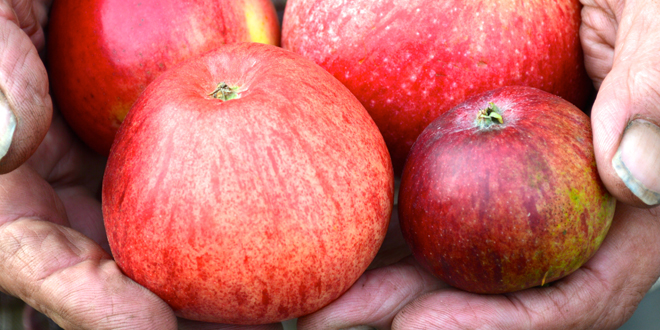Feb 9, 2016Growing demand for hard cider fuels growing demand for apples
Global alcohol sales are in decline overall, but that’s not the case with hard cider.
Today, the global market consumes about 635 million gallons of hard cider a year, a number that’s projected to grow. By 2020, 435 million tons of apples will be needed to supply the world’s cider consumers, said Neil Macdonald of Orchard Park Farm and Orchard Pig, a cider business in southwest England.
“Where on earth are those apples going to come from?” Macdonald asked. “Sixty percent of the world’s apples come from China now, but not a single one of them is good for cider making.”
The United States is responsible for much of hard cider’s global growth. The U.S. industry, still relatively new, has grown at an annual average of 73 percent since 2008. If that growth rate continues, nearly 10 percent of the U.S. apple supply will go into hard cider by 2018, said Nikki Rothwell, a Michigan State University (MSU) Extension educator.
“If we’re going to sustain this industry, we’re going to have to grow more fruit,” Rothwell said.
She and Macdonald spoke during the recent Great Lakes Fruit, Vegetable and Farm Market EXPO in Grand Rapids, Michigan.
Rothwell said the U.S. industry not only needs more apples, but better varieties. And those varieties need to work for the three main parties: cider makers, growers and nurseries.
Cider makers want varieties that are small, high in tannins and either bittersweet or bittersharp. Growers want disease-resistant, high-yielding, consistent croppers. Nurseries don’t want to bud thousands of different apples. What all three groups need to do is agree on the 10 or 20 varieties that work best for all, she said.
“We need to figure out how to whittle thousands and thousands of apples down to something that’s manageable.”
Easier said than done. There are plenty of traditional hard cider varieties in other parts of the world, but their availability in the United States is limited, and little is known about their growing habits or susceptibility to disease – especially fire blight and apple scab, Rothwell said.
An MSU research team is working to develop best recommendations for planting and managing hard cider orchards, as well as coming up with the best recommendations for (regionally specific) cultivars. The team also wants to determine the best processing and fermentation practices for hard cider makers, and provide an assessment of the industry’s economic opportunities and risks, according to Rothwell.
MSU has applied for a $5.5 million grant through USDA’s Specialty Crop Research Initiative to help pay for the research, she said.
As part of the project, MSU has purchased 300 cider apple trees (10 trees each of 30 varieties) that will be planted at the university’s plant pathology farm this spring. Among other things, the planting will be used to study apple scab. The researchers haven’t found a good way to assess scab so far, but they’ve had better luck studying fire blight. According to Rothwell, who works at the Northwest Michigan Horticulture Research Center, the research team has found a handful of cider varieties that are not as sensitive to fire blight but still grow well in northwest Michigan. These include Frequin Rouge, Burgundy, Bulmer’s Norman and Adams Apple.
English cider
Neil Macdonald lives in Somerset County, one of the epicenters of English cider production. Orchard Pig, his cider business, produces about 3 million liters of hard cider a year, made from roughly 800 acres of apples.
In the United Kingdom, hard cider is more popular than it was a decade ago. Back in 2006, cider made up 1.2 percent of the country’s total alcohol sales. By 2015, cider’s portion was holding steady at 9.8 percent. Behind that “amazing growth” was what Macdonald called the “Magners factor” – a big advertising campaign for Magners Irish Cider that ended up lifting the whole industry. The campaign boosted consumption among women, especially, who now make up about half the UK’s cider market.
“We’re pretty fond of this product,” Macdonald said.
Though North American sales are on the move, Europe still dominates the global cider industry.
“If you want to buy cheap concentrate, you’ll find it in Europe,” he said.
Within Europe, the United Kingdom still dominates – even against the French, who are “excellent cider makers,” Macdonald said. In 2013, 70 percent of the UK’s hard cider was made and consumed within the country. That’s down to 47 percent today, which demonstrates just how much growth is taking place across the globe.
UK cider-apple growers are commodity producers, who want to produce as cheaply as they can. When it comes to their buyers, the cider makers, the growers’ biggest goal is to make sure their apples have an adequate supply of tannins – the plant compounds that give cider its body, astringency and character, Macdonald said.
“You can get sugar out of a bag, but not tannins,” he said.
Because cider apples are a commodity, prime farmland might not be the best place for a cider orchard. Traditional UK cider orchards have a lifespan of about 80 years, and are laid out for mechanical pruning and harvest. Cider apples must be fully ripe before they’re picked. They can be picked off the ground with no food safety concerns (thanks to the fermentation process), but they need to be processed within 24 hours, Macdonald said.
Hard cider rootstocks in the UK are large and vigorous. Some growers have tried modern high-density systems, but they’re not suitable for mechanical harvesting. Macdonald recommended rootstocks no smaller than 111, because cider trees “take a hammering.”
— Matt Milkovich, managing editor















